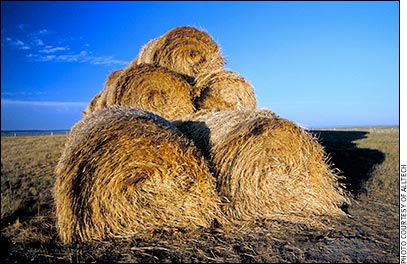Avoid Wet Hay
Make quality hay even when the sun doesn’t shine.
This season’s moderate to heavy rainfall from the Midwest and Ohio Valley to the central Appalachians and Carolinas has presented numerous challenges for farmers putting up hay. The added moisture has prevented plant maturity and cutting at the proper time. Cut hay has been rained upon, and the wet ground has exacerbated the drying time for hay ready to bale. The wet conditions can diminish hay quality through increased dry-matter (DM) losses, reduced nutritive value, escalated heat and even increased mold content.
According to Max Hawkins, a nutritionist with Alltech’s Mycotoxin Management Team, hay will lose 5%-6% DM until the hay reaches 40% moisture during the drying process.

Dry-matter losses increase as large bales are placed under different storage moisture conditions. Buffered propionic acid is one way to combat mold and heating and to decrease nutritive and dry-matter loss in hay.
“After this point, DM loss is often due to mechanical issues (raking and baling), with an average 15% loss mainly to leaves,” Hawkins said. “Crimping can greatly reduce DM waste by decreasing drying time, time in the field and leaf and respiration loss.”
Generally, 18%-22% moisture is the upper limit for hay to be baled. Moisture levels above this window can result in increased DM loss, often from excessive heat and mold. Large round bales can retain heat longer than conventional bales and should be baled at lower percentage moisture (less than 18%).
“All forages above 15% moisture will undergo some degree of heating,” Hawkins said. “The amount of heating depends on the moisture level and mold development. Storage hay temperature is elevated by microorganisms and plant respiration.”
Temperatures can reach a level that will result in spontaneous combustion; however, temperatures below combustion point can still cause mold growth and also significant losses in forage quality and quantity. Carbohydrates and protein can be reduced as carbohydrates are used as a food source by microbes, and protein is often bound in an unavailable form (browning).
Preservatives have been used as one method to cope with high moisture levels. Buffered propionic acid can also combat mold and heating. According to Hawkins, there is less nutritive and DM loss when buffered propionic acid is applied. Application rate is determined by percentage moisture level, and the manufacturers’ recommendations should be followed.
Hawkins also recommends utilizing a management program such as Alltech’s On-farm Mycotoxin Hazard Analysis (MIKO) program to evaluate the heating and molding issues.
“Probing hay bales for temperature and thermal imaging can identify temperature issues due to heating and locate problem spots in the stored bales. The 37+TM mycotoxin analysis program can investigate samples taken to identify any issues with mycotoxins due to increased mold growth,” Hawkins said. “Together these programs can assist the producer to better manage the issues with hay that has been harvested and baled in less-than-ideal weather conditions.”

Editor’s Note: This release is from Alltech.





